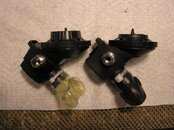Timothy Moran
Registered
I have 6 D-Series regs. There are 2 different configurations of PN 11-011-122 diaphragm covers on them. One is what I call the "tall" version, and the other is the "short" version. I have reviewed all the schematics, kit lists, etc. I have, and can find no reference to these 2 different configurations of diaphragm covers. Thinking about this, the only two effects I have come up with, are cover height difference (1) affects exhaust bubble dispersion; and (2) affects water flow over the exhaust flapper during sideways current flow into one side of the exhaust rubber cover.
Do any of you "SP reg heads" out there know the reason for the differences? - - performance enhancements? - - product improvement? - - undocumented production change? - - change at D350, or D400 production? - - or whatever?
I didn't bother posting this question in the SP mfg forum as they never seem to answer questions about vintage unsupported regs.
Thanks in advance,
TJ Moran
Do any of you "SP reg heads" out there know the reason for the differences? - - performance enhancements? - - product improvement? - - undocumented production change? - - change at D350, or D400 production? - - or whatever?
I didn't bother posting this question in the SP mfg forum as they never seem to answer questions about vintage unsupported regs.
Thanks in advance,
TJ Moran
Attachments
Last edited:




